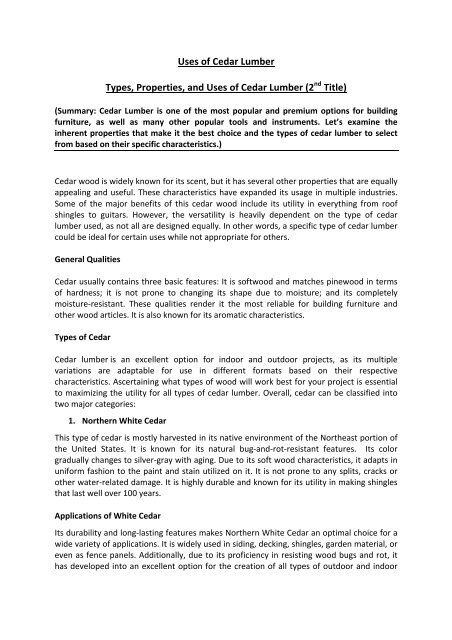Uses of Cedar Lumber
Cedar wood is widely known for its scent, but it has several other properties that are equally appealing and useful. These characteristics have expanded its usage in multiple industries. Some of the major benefits of this cedar wood include its utility in everything from roof shingles to guitars.
Cedar wood is widely known for its scent, but it has several other properties that are equally appealing and useful. These characteristics have expanded its usage in multiple industries. Some of the major benefits of this cedar wood include its utility in everything from roof shingles to guitars.
Create successful ePaper yourself
Turn your PDF publications into a flip-book with our unique Google optimized e-Paper software.
<strong>Uses</strong> <strong>of</strong> <strong>Cedar</strong> <strong>Lumber</strong><br />
Types, Properties, and <strong>Uses</strong> <strong>of</strong> <strong>Cedar</strong> <strong>Lumber</strong> (2 nd Title)<br />
(Summary: <strong>Cedar</strong> <strong>Lumber</strong> is one <strong>of</strong> the most popular and premium options for building<br />
furniture, as well as many other popular tools and instruments. Let’s examine the<br />
inherent properties that make it the best choice and the types <strong>of</strong> cedar lumber to select<br />
from based on their specific characteristics.)<br />
<strong>Cedar</strong> wood is widely known for its scent, but it has several other properties that are equally<br />
appealing and useful. These characteristics have expanded its usage in multiple industries.<br />
Some <strong>of</strong> the major benefits <strong>of</strong> this cedar wood include its utility in everything from ro<strong>of</strong><br />
shingles to guitars. However, the versatility is heavily dependent on the type <strong>of</strong> cedar<br />
lumber used, as not all are designed equally. In other words, a specific type <strong>of</strong> cedar lumber<br />
could be ideal for certain uses while not appropriate for others.<br />
General Qualities<br />
<strong>Cedar</strong> usually contains three basic features: It is s<strong>of</strong>twood and matches pinewood in terms<br />
<strong>of</strong> hardness; it is not prone to changing its shape due to moisture; and its completely<br />
moisture-resistant. These qualities render it the most reliable for building furniture and<br />
other wood articles. It is also known for its aromatic characteristics.<br />
Types <strong>of</strong> <strong>Cedar</strong><br />
<strong>Cedar</strong> lumber is an excellent option for indoor and outdoor projects, as its multiple<br />
variations are adaptable for use in different formats based on their respective<br />
characteristics. Ascertaining what types <strong>of</strong> wood will work best for your project is essential<br />
to maximizing the utility for all types <strong>of</strong> cedar lumber. Overall, cedar can be classified into<br />
two major categories:<br />
1. Northern White <strong>Cedar</strong><br />
This type <strong>of</strong> cedar is mostly harvested in its native environment <strong>of</strong> the Northeast portion <strong>of</strong><br />
the United States. It is known for its natural bug-and-rot-resistant features. Its color<br />
gradually changes to silver-gray with aging. Due to its s<strong>of</strong>t wood characteristics, it adapts in<br />
uniform fashion to the paint and stain utilized on it. It is not prone to any splits, cracks or<br />
other water-related damage. It is highly durable and known for its utility in making shingles<br />
that last well over 100 years.<br />
Applications <strong>of</strong> White <strong>Cedar</strong><br />
Its durability and long-lasting features makes Northern White <strong>Cedar</strong> an optimal choice for a<br />
wide variety <strong>of</strong> applications. It is widely used in siding, decking, shingles, garden material, or<br />
even as fence panels. Additionally, due to its pr<strong>of</strong>iciency in resisting wood bugs and rot, it<br />
has developed into an excellent option for the creation <strong>of</strong> all types <strong>of</strong> outdoor and indoor
furniture. It is also a common material used in aquatic equipment, including in the<br />
construction <strong>of</strong> saunas, ships, boats, canoe ribs, etc.<br />
2. Western Red <strong>Cedar</strong><br />
Western Red <strong>Cedar</strong> is native to the region <strong>of</strong> the Pacific Northwest that ranges from South<br />
Alaska to Oregon. Because <strong>of</strong> its decay-resistant features, it is considered one <strong>of</strong> the most<br />
durable and popular lumbers <strong>of</strong> the area. It darkens as it ages, which results in a beautiful<br />
dark brown-red shade. It has a naturally straight grain and is extremely lightweight. It also<br />
emits a subtle aroma that serves to enhance its appeal even further.<br />
Western Red <strong>Cedar</strong> is specifically known for its resonant qualities, that, when combined<br />
with its stability and relative lightness, render it an excellent option for crafting musical<br />
instruments. Due to its resistance against warping and cracking – as well as its ability to<br />
enhance acoustic qualities -- this wood is mostly used in manufacturing guitars, violins and<br />
other similar wood-stringed instruments. These same properties also make it a popular<br />
choice for interior paneling in rooms and corridors.<br />
<strong>Uses</strong> for Red <strong>Cedar</strong><br />
Similar to White <strong>Cedar</strong>, Red <strong>Cedar</strong> is also well known for its durability and resistance to the<br />
elements, making it an optimal choice for a variety <strong>of</strong> outdoor projects, including siding,<br />
ro<strong>of</strong>ing and fencing work. Red <strong>Cedar</strong> is equally effective for indoor construction, especially<br />
in humid climates, as it never warps or swells in such weather. Due to its natural aromatic<br />
properties, it is also a popular choice in furniture fabrication. One common example <strong>of</strong> the<br />
latter is cedar chests, which are <strong>of</strong>ten used to store valuable and/or personally meaningful<br />
items. These are frequently crafted from Red <strong>Cedar</strong>, as its properties are essential in<br />
preventing bug and termite infestations.<br />
Whether you are planning to use White <strong>Cedar</strong> or Red <strong>Cedar</strong> in Miami, one thing is clear --<br />
this type <strong>of</strong> lumber is one <strong>of</strong> the most durable and robust wood options on the market due<br />
to its insulating and decay-resistant properties.



